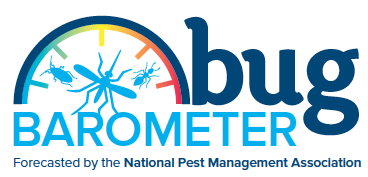The Bug Barometer
The Bug Forecast for Spring and Summer

Predicting the weather can be a hit-or-miss process, but guessing what insect pests might do is a more exact science. The National Pest Management Association recently released its semi-annual Bug Barometer, which offers consumers a sneak peek at the predicted insect pest activity levels this spring and summer.
The Bug Barometer was developed by the NPMA’s expert entomologists. These scientists examine recent weather reports across the United States and analyze precipitation patterns to determine the weather’s effect on the pest pressure index.
Inconsistent weather patterns can alter when, and even where, pests become active. The Clark Man wanted to share the barometer to help our customers be better prepared by taking the necessary steps to safeguard their homes.
Jim Fredericks, NPMA’s chief entomologist says the two main weather factors that affect bug populations are, one, temperature, and two, rainfall or other precipitation. Pests such as ants, termites, and mosquitoes are most likely to respond favorably to moist conditions. Excess rainfall can create standing water where certain insects can lay eggs, and larvae also thrive in standing water.
Temperature plays a role, too, as insects are not warm-blooded like mammals, which means they tend to become more active as the temperature heats up.
"There are a number of pests that overwinter or harbor inside buildings to stay warm in the winter," says Fredericks. “A mild winter could mean that more bugs managed to find cozy places to hide from the cold, and that fewer insects were exposed to freezing temperatures that could cut their populations down.”
Most of the country – including California – experienced a mild and wet winter. Here is the expected pest forecast for each region of the United States:
Northwest and West Coast: Heavier rainfall, flooding, and snowfall due to the El Niño weather pattern affected this portion of the country during the winter months. With slightly rainier-than-normal weather predicted for the upcoming seasons, ants will be looking to move indoors from their saturated nests.
How is the rest of the country predicted to fare this spring and summer pests?
Northeast: Starting with an atypically dry December, the Northeast closed out the month with much wetter and warmer weather than usual, with little snowfall. These conditions gave way to earlier pest activity, creating expectations that ants, ticks, and brown marmorated stink bugs will arrive with the early thaw.
Southeast: A rainier and warmer winter than usual created strong breeding grounds for mosquitoes that will continue to thrive. Termite swarms and ants will emerge in their fullest force during the hottest periods of spring and summer.
Midwest: Wetter than average weather combined with a record-breaking warm December may jump-start ant and tick activity. This is in addition to the premature mosquito population increase already occurring.
Southwest: This region experienced an exceptionally warm December and especially wet conditions, with the exception of a dry southern Texas. A cooler, rainier spring may delay termite swarms, drive up mosquito populations, and lead ants indoors. A drier summer could yield an increase in tick populations.
Remember, if you have question on how to keep pests out of your home, call or text (800) WE-NEED-YOU (936-3339) or drop me an email at clarkcares@clarkpest.com.
Until next time, I’m the Clark Man, and thanks for helping me keep unwanted pests out of your home.


